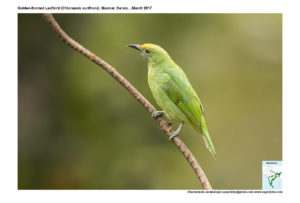
Golden-fronted Leafbird Chloropsis aurifrons
Etymology:
- Chloropsis: Greek word khlros – green; opsis-
- Aurifrons : Greek word Auri –gold ; Frons is fronted
Vernacular Names: Hindi: Suvarna-bhal Harewa, Sabz harewa, Chhota harrial, Chhota harewa, Sans: Suvarna-bhal patragupt, Pun: Pattar, Ben: Harewa, Lepcha: Skalem-pho, Guj: Harevo, Soneri bhal harevo, Mar: Hirva bulbul, Sonkapali Parnapakshi, Ta: Pachai kuruvi, Te: Pachchaku pitta, Mal: Ilakkli, Kan: Yelehakki, Sinh: Nil-kurulla, Gira-kurulla
Distribution in India: Resident of Himalayas, North East, East, South and South west India.
Description:Size of 18-19 cm. The male of nominate race has orange forehead and forecrown; black mask extending from lores and eye to lower throat, within which entire chin, upper throat and malar region violet-blue; broad and prominent yellow band around lower part of bib; turquoise-blue lesser upper wing-coverts; all other plumage bright grass-green; iris dark brown; bill black; feet greenish-slate. Female differs from male only in having rather less blue on lesser wing-coverts, and in slightly smaller size; orange of forecrown tends to be somewhat duller .
Habitat: It is found in canopy of deciduous forest to relatively open semi-evergreen to fully evergreen broadleaf forests, forest edge, secondary growth , tree plantations, wooded stands in coffee and tea estates, and wooded gardens.
Food Habits: Its eats arthropods, fruits and nectar. Loners, pairs or small parties forage for arthropods in canopy foliage, often acrobatically on thin outer twigs; pursues flushed items, also takes winged termites. Some flower-visiting is also for purpose of seeking insects. Fruits include figs and berries; small fruit items eaten directly, but medium-sized, tough-coated items are pierced, and the contents then loosened and squeezed out by using the bill. Nectar is important in diet, and sources are at times defended individually. Nectar reached for in tubular corollas, often by hanging with head downwards, occasionally while hovering. Nectar of bananas also taken, by puncturing base of tubular corolla.
Breeding Habits: They breed in Feb- Aug in India. The nest is built by both pair-members, one site-guarding while the other forages for materials. The nest is an open cup of fine twigs, bryophytes, tendrils, grass, bark fiber, bamboo leaves and always some cobweb, sparsely lined with grass, secured hammock-like between thin prongs of outer fork. They lay a clutch of 2 eggs. The incubation period is 14 days and fledging period is 15 days.